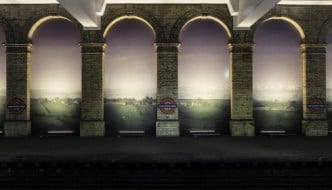In Conversation With Electronic Artist Jim Campbell
June 22, 2015
Jim Campbell, is a San Francisco based artist, who produces light installations and other art works using mixed-media electronics. Trained in engineering, and clearly influenced by his past, he has an international acclaim. Part of his collection is held in public galleries such as the Metropolitan Museum of Art, New York. His often seemingly aesthetically simple pieces and installations are both evocative and intriguing; they call upon the viewer to explore and understand them. His unique ways of producing art via various techniques and technological processes have given him the opportunity to create works which can be seen in many public institutions in the United States. Here, Nicola Cappleman asks Jim about his background, influences, and the ways in which he produces art…

© Jim Campbell
TSTOA: Can you talk me through your background? How did you get into making art?
JC: I trained as an engineer with a keen interest in film-making. During the period of about 20 years between 1988 – 2008 or I made a gradual transition from engineering full time to making art full time. In the beginning I moved to art as a way of finding balance in my life. I looked for a balance in my ways of thinking and searched for a way to explore creativity and use the other, non-scientific half of my brain. There’s creativity in engineering too of course, but just in a different way.

© Jim Campbell
TSTOA: Is there anything specific which you intend to explore in your work? What do you look to portray?
JC: My earlier work was interactive, using cameras as a way to incorporate the viewers into the work. In later years I moved on from making interactive work to making work which was about perception – I used very small amounts of information, in particular, light in the pieces. I used these pieces of information in a way, which would generate an emotional response. My latter work is not necessarily interactive per se as they don’t respond to the viewer. However they do ask the viewer to perceive them in similar ways in which they would view a sculptural piece due to their structure. So I ask the viewer to participate in trying to understand the work at the same time in which they are experiencing them. But when I say ‘understand’ I don’t mean from an intellectual perspective I mean understand in a purely emotional and perceptual perspective.

© Jim Campbell
TSTOA: Are there any artists who inspire you?
JC: Perhaps early on I wouldn’t say I was inspired by James Turell as I didn’t know the work that well. But I would say I see James Turell and artists who produce similar kinds of minimal light based work as continuing to be inspiring to me.
TSTOA: You have an international profile, and you have exhibited work in many different places, are there any places you have visited which have influenced your work at all?
JC: Generally speaking I wouldn’t say that my work is inspired by specific trips I make. I have travelled a lot, I have been to India, for example, which I found to be very inspiring. Recently my work has been based around using very simple pieces of information in my installations, and a couple of years ago I visited Southern Italy to take photographs and study ancient mosaics. I looked at the process of making, and the goals of these mosaics – how that process, and end result, relates to the work that I am doing myself. Particularly, the way that something can be produced in a simple way and still have an emotional essence behind it. So trips like that I would consider being inspiring.

© Jim Campbell
TSOA: You are often categorised as a ‘New Media Artist’, is that something which you would categorise yourself as?
JC: I identify myself as an electronic artist, because everything that I do uses electronics and, of course, I am an electrical engineer by trade. When I started making this work back in 1988 there were relatively few artists making this type of work in comparison to now. To the point where I travelled around the world in the early 90’s to exhibitions and you would see the same faces, the same artists, at the same exhibitions from all over the world. The categorisation of artists is a difficult thing, and the area of producing art has changed dramatically also. The amount of people producing new media art has exploded in the last 20 years.

© Jim Campbell
TSOA: You have worked on a variety of different types of projects in the past few years, are there any particular types of things which you like working on? Do you prefer making art to exhibit yourself, or commercial art, which you produce for different public spaces?
JC: I make a big distinction between the public art, which I produce, and the non-public art. The goals and the whole making process end up being very different, partly because when you make public art it is not so much that it is ‘commercial’ but more that there is a commitment to do a certain thing – to produce art that the public will like. You have a commitment to make something, which is going to be liked by a variety of people. This is not the case when I make work that I am making for myself or for what I may show in a gallery.
In answer to your question I would say that there are very much two sides to what I do and I enjoy both equally, they compliment each other nicely. In many respects it’s nice to make a piece of work for yourself and not think about the audience or whether someone will like it. I do like working to produce work which will be displayed in places like airports, or train stations. A year ago, I completed a work at San Diego airport that took 3 or 4 years to make (seen above). I spent a long time while planning this piece thinking of how the travellers would respond to it. This is perhaps the most successful public art, which I have done to date.
Further information about Jim Campbell and his work can be found on his website.
Catch Jim Campbell’s ‘Rhythms of Perception’ at Espacio Fundación Telefónica Madrid until the 28th June.
Filed under: Art & Photography
Tagged with: art, artist, artist in the spotlight, electronics, installation, interview, light, media, mixed-media, new media art, San Francisco



Comments